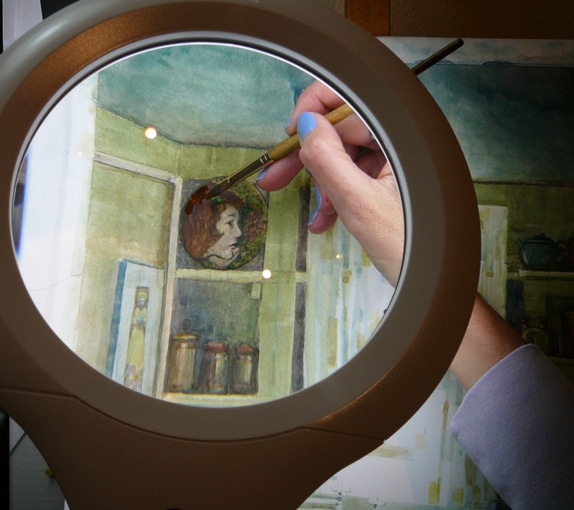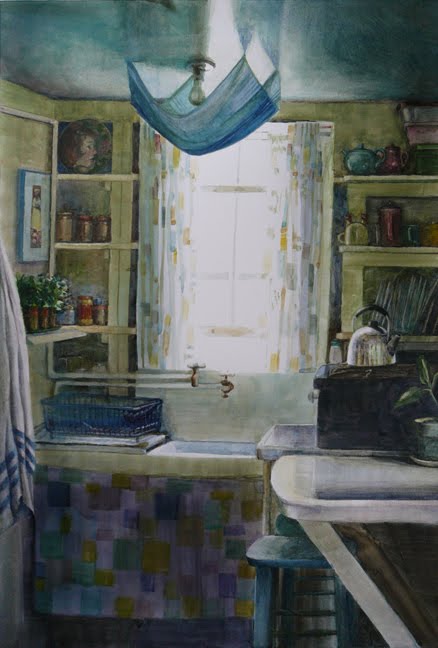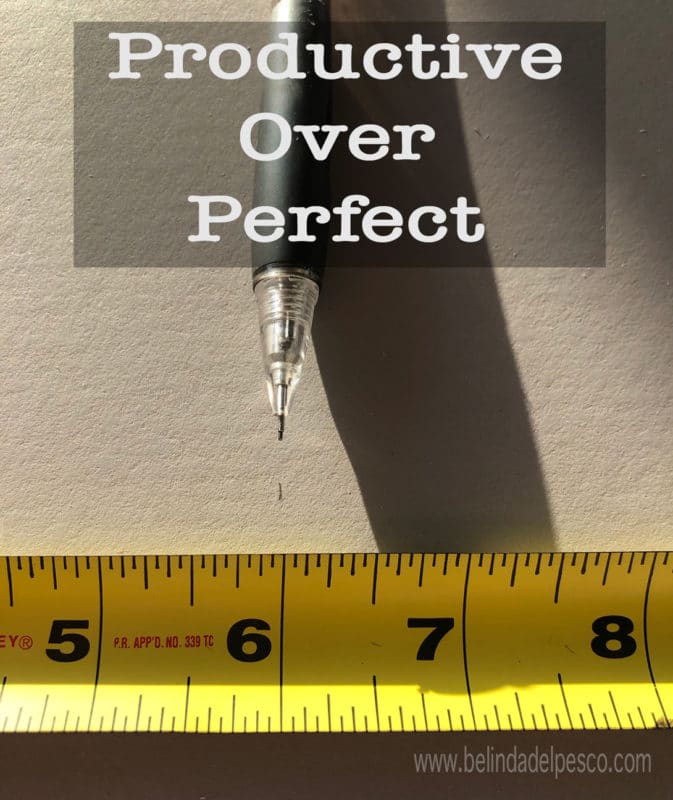Getting Past Ugly in Your Art
Making art often stalls in the Ugly Tunnel. On your pilgrimage to a finished watercolor, there’s a crossing in the journey where the pigments, composition and overall look of your work in process can get a bit wonky.
It’s important that you avoid stopping there. It would be easy to walk away from the art at this stage, because none of it looks encouraging.
This is especially true if you’re not sure how to paint through the discouraging scenery. Nevertheless, keep hiking.

A Thousand Decisions in Art
Every time your brush touches something – the pigments, the water, the paper – you’re making a decision.
If you don’t have ready answers, this can be exhausting.
Which color should I use?
How should I mix that color?
How much water should be in the pigments to get the right value?
If I put this shape in the painting, will it help or hurt my goals for the finished art?
When you’re just starting to paint, your sequence of movements between brush and paper can result in that ugly, where-am-I-going stage of making a watercolor.
It’s important to keep going to avoid a studio full of half-finished paintings.

Have Perspective, and Courage
Have courage. We are talking about pigments and paper. This is art, and we aren’t rescuing a drowning puppy. {Deep breath.}
If your painting fails, shrug it off, note the lessons in what to avoid in the next one, and start again.
Muscle-memory is developed with any repetitive action.
Do you have to think hard, and concentrate fully to button your shirt, or clasp and zip trousers? You can probably do these things without even looking – just by feel due to repetition and muscle memory.
Have you watched a child trying to master those same movements? They need help, and encouragement to keep from getting frustrated.
Take a deep breath, pick up your brush, and play with your paint. Those thousands of painting decisions will shrink with practice. Pinky promise.
Your brain will remember – without strain – how to mix a cool green, or feather a soft edge – with practice.
Leaving your art perpetually unfinished guarantees your lost chance for a favorable outcome. And rare success smothers your confidence.
Embrace the possibility of ‘mistakes’, and remind yourself that this is how learning works. Keep on painting.

Considerations and Tips for Finishing Your Art
There is no law against unfinished watercolors. I’ve left plenty of paintings in the Ugly Tunnel, so I’m speaking to myself as much as I’m sharing these mental notes with you. Here are a couple of things I’ve noticed about unfinished paintings. And some tips for getting them out of the tunnel sooner rather than later. [Share this with a friend who needs a boost.]
- The longer a painting sits, the older it gets. That is, the passion to paint that scene fades. If you’re not feeling it, paint something else on the back of the paper, and consider the verso of your new painting a previous lesson, completed.
- While we work on other art, and polish our noticing skills, the early mistakes in the unfinished painting bloom before our eyes. Oftentimes, it makes more sense to paint that image over again, fresh. If the subject still entices us – start over, rather than struggle to repair floundering elements. We’ve improved since that painting was started, so let’s leave our mistakes over there, and begin again.
- When All the Things in the painting are yelling for a solution simultaneously, segment the composition to work in parcels. In the painting above, I worked in quarters; upper right, upper left, lower right, lower left. It was more relaxed to focus on fenced acreage – with frequent breaks to step back and take in the whole property for cohesion.
- If you’re perpetually distracted by the entirety, lay printer paper over the parts of the painting you’re not working on. Tape paper together like a surgical sheet draped with a cut-out over your workspace. You can do the same thing to your reference material, to match what’s visible on your painting. Curtain the stage to keep your focus centered on one scene at a time.
- If you feel stuck, prop the painting and your reference materials up, and put a chair at least 8 feet away. Grab a notepad and a cup of something to drink, and have a seat. Look at your painting, and your reference materials – back and forth – through squinted eyes. Take notes on whether your values are right, if your shapes need adjusting. Notice the path your eyes follow to “read” the image. If you don’t have 8 feet of space, put your back to the painting, and look at both the painting and the reference in a mirror over your shoulder. Jot down some adjustments and To-Do’s, and get back to it with your very own marching orders. Be the Boss.

Lend a Hand Up
This amazing community of painters has magic cupboards full of ideas to get past the ugly phase of a watercolor. Please share your tips and tricks with us in the comments. Painting is a solo endeavor, but there’s accelerated learning in a community. Creators need each other to stay encouraged, and move forward with conviction and purpose. All hands in for a Yes on that?
Thanks for stopping by and I’ll see you in the next post!
Belinda
P.S. I needed a solution to store full sheets of watercolor paper (22×30), and I found these perfectly sized folders. I’m using one for unframed watercolors, and the other for storing watercolor paper flat and clean. How do you store watercolor paper?
Art Quote
Love is the most powerful and underused force for change in the world. For me, love is the effort to help others flourish – and it often begins with lifting up a person’s self image.
Melinda French Gates



I am just starting out learning, finding my way. Your paintings fill me with inspiration and wonder, the way you capture light and the subjects you paint is just perfect. I am enjoying reading your blog and your Youtube videos and descriptions are so very helpful and fascinating. I love that you show us unfinished stages of your paintings so that we can get an idea of the layers it takes to get such depth of colour and finish your wonderful work. Thank you for your art x
Hi there, Sue! Thank you for your wonderful note, and your warm encouragement. And welcome to watercolors! I hope you find enough process in these posts and the youtube videos to open doors, and keep your journey of discovery moving forward. It’s such a simple medium: pigments, gum arabic, water, a brush and paper…. it travels well, moves through your life in a tote bag, and produces magical effects with very little fussing. If you have any puzzles to solve over watercolor, I’m happy to ponder and brainstorm, so feel free to reach out. Thank you for sending such kind feedback.
Really lovely light and air, Belinda. ? I’m off to Greece to sketch with Frenchfusion on Thursday?
Hi Bobbie! Thanks for the compliments, and happy travels and art-making in Greece!
Belinda, this was exactly what I needed today! Your painting is lovely and your words are perfect. Have a fabulous day!
Thank for the feedback, and yayyyy with confetti that the timing was right for you. Stay with it, love!
Commenting here on your good advice to keep on going and not to collect a bunch of unfinished work. I have proof of that being a bad practice. I had twenty pieces “waiting around” to become perfect and finished. The Thomas fire hit and they went up in smoke! How often I wish that I had turned a blind eye to all the little changes I was going to make one day. Those paintings would be housed safely with some loving collector.
Lesson learned. Put your art out into the world where it belongs.
Oh Didi, your story of lost art is a sad, hard experience. Paintings have such an investment of time and effort and big-wishes for what they’ll become. I think the bank of what we’ve already poured into a painting can freeze us into worrying how to finish so we don’t screw up what’s already been labored over. But then to lose so many of them, and the studio where they were made in a fire! My heart aches for you, love. XO Yes, Put your work into the world, and let someone experience the joy of gazing at it for years to come.
My pen-and-ink drawings have always had what I call an ugly duckling stage. I’ll look at what I’m working on and think “this is never going to be good”. It’s usually the point at which the drawing is mostly still just a jumble of lines of shapes. Very flat, no dimension at all. And I’ve just begun started adding the hatching/cross hatching. As you say, I know that if I just keeping going I can begin to see the ugly duckling becoming the beautiful swan. This happens with every drawing and I’ve been creating pen-and-ink drawings for 28 years. Just keep at it.
Excellent advice, my friend! Just keep at it. Stopping midway in the process will keep the art in that ugly duckling stage forever, and we all want swans! Your seasoned advice will be helpful to artists reading this who have just started out. Thanks so much for chiming in. 🙂
Great advice and beautiful work. Luckily our brains change. I’ve taken out work I could not
look at for months, suddenly known exactly what to do, changed it, and sold it! If we have time,
time can help. Wonderful post. Thanks for your continuing inspiration.
XOXOXOXOXO Barbara
Hi Barbara, I think that’s a good point…. time can tell us what to do with an unfinished painting. I’m glad you’ve had such a good experience with a wait-and-see approach.?
This is such an uplifting and important post! The ugly stage probably stops 75% of artists on a regular basis, and this comment is absolute truth: “Leaving your art perpetually unfinished guarantees your lost chance for a favorable outcome. And rare success smothers your confidence.”
I run into a roadblock in 90% of my work and it’s so much easier to clean my brushes and disappear for a week. Accepting imperfection is the only road to progress. Thank you for a wonderful website and endless generosity!
Hi Lauren, I’m glad you found this post encouraging. Your comment about accepting imperfection as the only road to progress is Right On. If we could just get our need for premature mastery locked up to enjoy the process, we’d have so much more fun in the studio! Thanks for your note, and your shared encouragement.
When I order full-size sheets of watercolour paper, they are delivered flat in sturdy cardboard boxes, so I hang onto them for my storage. I don’t have room to store them flat, so they are stacked on edge behind my desk.
Hi Sonia! Yay for sturdy boxes that can be stored up on their ends! For folks who have never ordered full sheets of paper online, this is a great tip!
I read your blog faithfully. Fascinated with the print making ..currently on my bucket list. This post is one I will share with several people. It soeaks to me, and I know will do the same for them. Thank you. Janene.
Hello Janene – Thanks for walking with me for so long! I hope the printmaking teasers tempt you to pull some supplies out on your kitchen table for a little spin. The course I’m building online is full of shortcuts and tips to create prints with everyday objects and it’s So Fun! Thank you for hangin out here, and for sharing the enthusiasm.